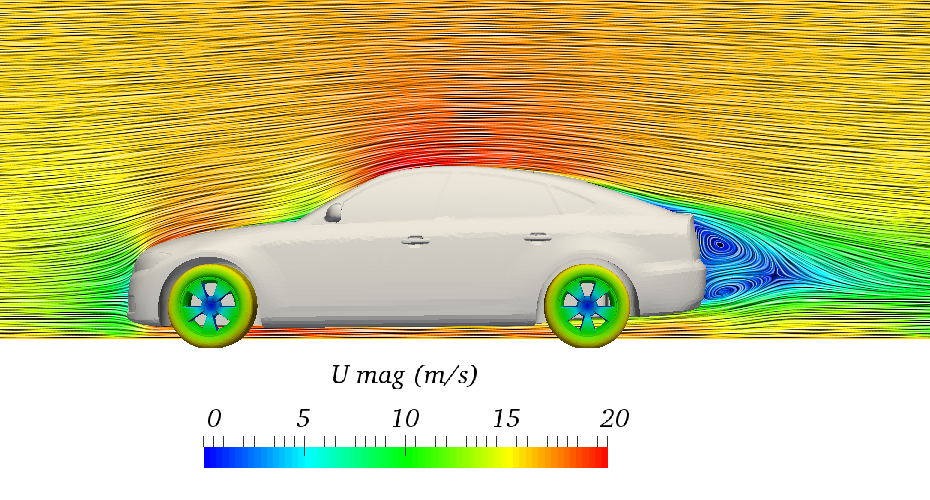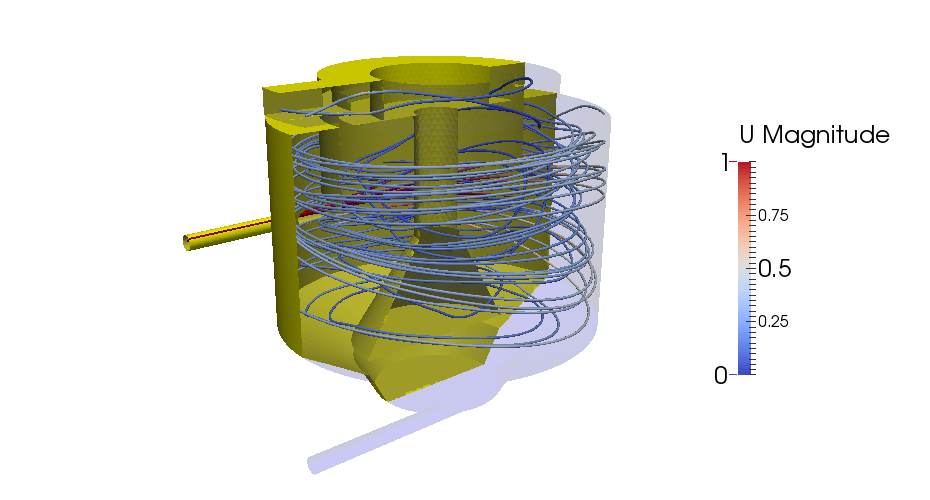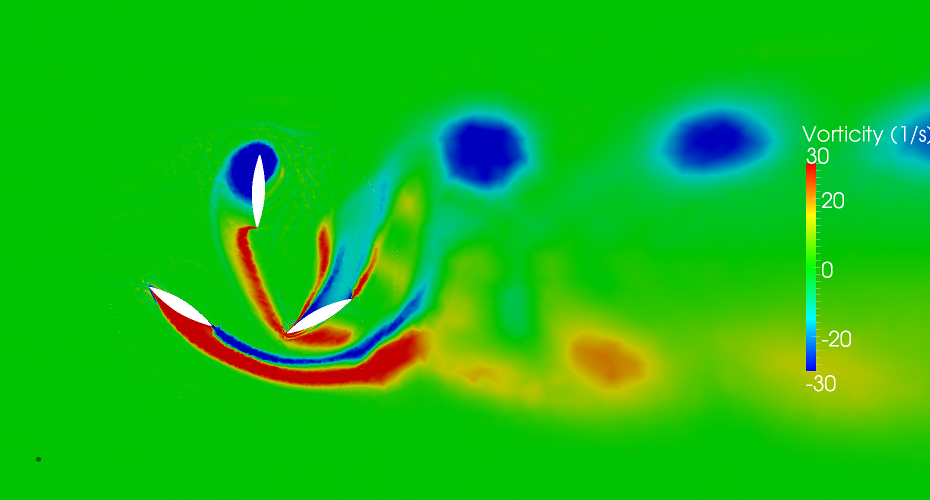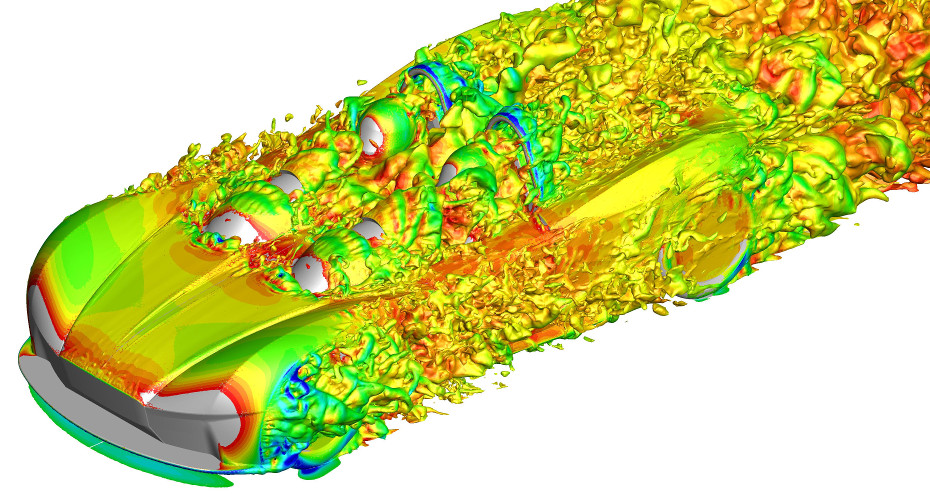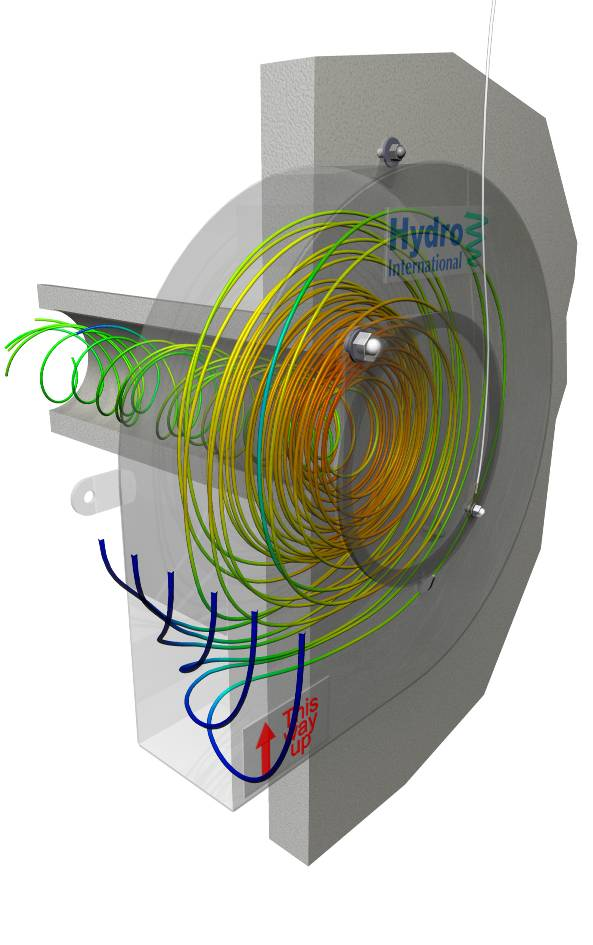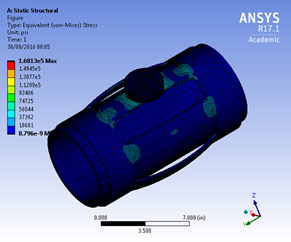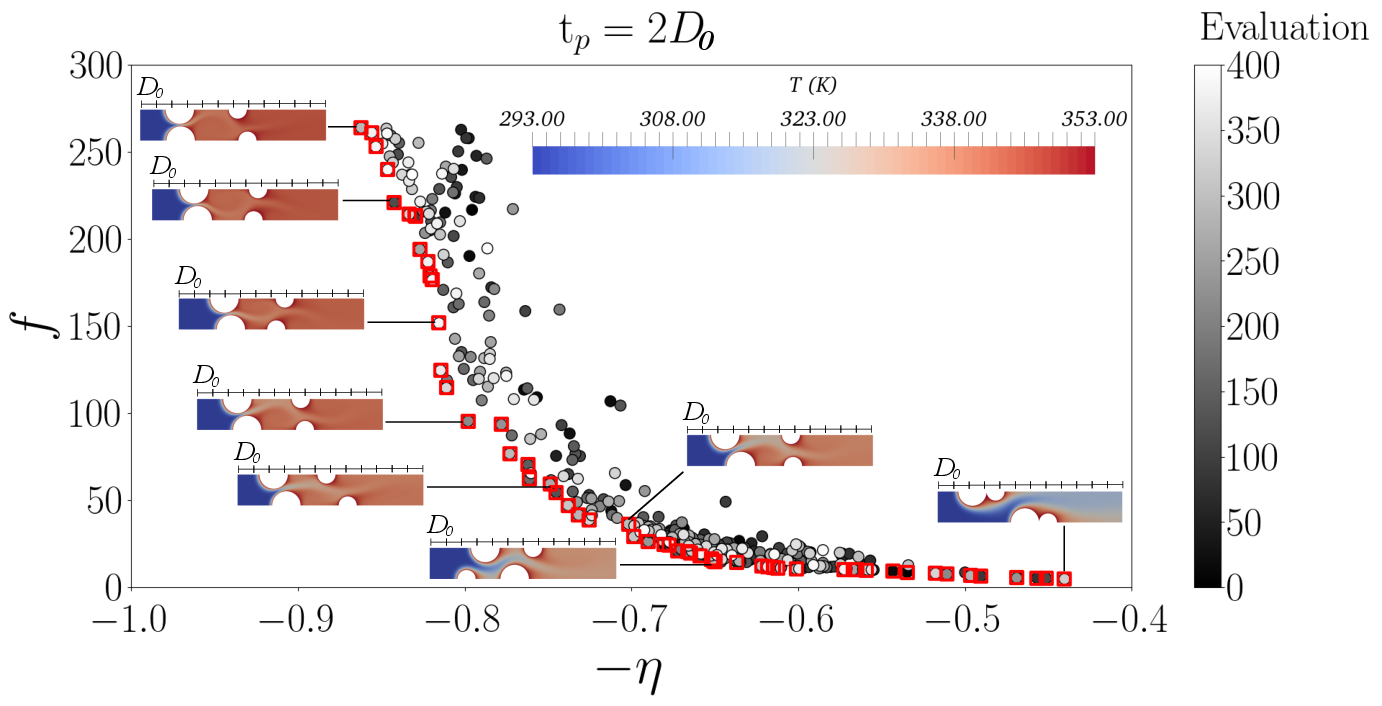Computational Engineering
Computational Engineering
Computational Engineering
Computational Engineering
Computational Engineering is the use of computers to simulate and understand engineering problems. In the Computational Engineering group we develop and use a range of techniques - Computational Fluid Dynamics, Finite Element Analysis, Surrogate Modelling, Optimisation and Machine Learning - and apply these to real world problems in industry and medicine.
Our work is supported by a range of research grants and we often work with industrial partners - take a look at some of the collaborations and projects currently active.
Group members
| Academic | Research Interests |
|---|---|
| Prof Tim Dodwell | Generalised Multiscale FEA, modelling complex materials, HPC |
| Prof Akbar Javadi | FEA/extended FEA, Optimisation and Data Mining, applications to geomechanical problems - group web page |
| Dr David Moxey | CFD, high-order methods, mesh generation and high performance computing - personal web page |
| Prof Chris Smith | FEA, meshless methods, discrete element methods, reduced order modelling |
| Prof Gavin Tabor | CFD, Optimisation, Applications of CFD |
Techniques
Click on the following tabs to learn more about the techniques we are developing.
Computational Fluid Dynamics - CFD
CFD is the simulation of fluid flow problems using computers. Fluids are everywhere - air flows around cars and aircraft, water flow in rivers and drains, blood in the human circulatory system. CFD can be applied to predict the behaviour of these fluids and thus help develop better vehicles, improve our control of the natural environment and advance medical techniques.
In the Computational Engineering group we work on the development of two Open Source codes; OpenFOAM and Nektar++. OpenFOAM is the leading Open Source CFD code, using 2nd order Finite Volume methods. Used worldwide, it is an advanced, general purpose code with modelling for turbulence, multiphase and free surface flow, combustion and reaction, and various types of mesh motion. Prof Tabor has been involved in its development since its inception, and is Chair of the Joint Technical Committees for the OpenFOAM Governance initiative.
Nektar++ is a high order Finite Element code which is being developed at Exeter alongside Imperial College and the University of Utah; Dr Moxey is one of the project leaders of the development team.
Work at Exeter covers the full range of fundamental development, modelling, and applications in industry and other areas (such as biomedical research). Research interests include HPC and algorithms, turbulence modelling including Large Eddy Simulation, multiphase (free surface, dispersed phase, scour, phase change) and combustion (biofuels), meshing, and optimisation using CFD. Industrial applications include aerospace, automotive, Urban Drainage, renewable energy (wind and tidal turbines) - we work with leading international companies such as McLaren and Arup, and SMEs such as Hydro International.
Finite Element Analysis (FEA)
FEA is a numerical technique for solving systems of Partial Differential Equations by discretising on a lattice of points linked by edges. Various strategies for discretisation are possible relating to different mesh structures, element types and basis or shape functions; each discretisation strategy has advantages and disadvantages. The solution of the governing equations can then be expressed as a minimisation, variational problem and solved numerically; again, a wide range of choices can be made of algorithms and methods to accomplish these processes.
FEA can be applied to solve any Engineering or Physics problem that can be expressed as a continuum mechanics problem - it is most commonly used for structural and vibrational analysis, heat transfer and electromagnetic problems. Applications in industry abound, and it is a key technique in industrial modelling and prototyping in Industry 4.0. We work with both commercial and in-house codes.
A number of group members are actively researching and/or using FEA methods, with specific interests as follows:
- Prof Akbar Javadi - Extended and self-learning FEA, modelling of civil engineering hydraulics (seawater intrusion, flow and contaminant transport in soils and fractured rocks, hydraulic fracturing for unconventional oil and gas reservoirs), modelling of biomechanical systems
- Dr Tim Dodwell - Generalised Multiscale Finite Elements, Numerical techniques (e.g. parallel iterative solvers), applications for composite materials and subsurface flow
- Dr David Moxey - High order Finite Elements, particularly for CFD, Mesh Generation techniques
- Prof Chris Smith - Industrial Applications of FEA for vibration, contact problems, coupled solid-particle problems. Fast simulation for industry
Mesh Generation
CFD and FEA methods rely on decomposing the domain of interest into a large number of elements or cells - comprising a grid or mesh. Creating this mesh for complex geometries is highly challenging, whilst at the same time being of crucial importance in getting a good solution. Here in Exeter we are at the cutting edge of research in meshing in a number of areas, including
- Image-Based Meshing (IBM). IBM involves processing 3d scans from MRI and CT to identify and mesh regions of interest. Prof Gavin Tabor has collaborated with Simpleware on developing IBM methods for CFD. These have typically been applied in biofluid mechanics - patient-specific models of arteries, airways etc - but can also be used for modelling complex geometric problems (flow through packed beds, filter networks).
- Dr David Moxey is actively researching high order mesh generation methods to work with Nektar++.
- Prof Gavin Tabor is also leading research into mesh optimisation using evolutionary and machine learning techniques. These can be used to automate the process of improving the quality of the mesh - see the paper in Engineering with Computers
Meshless methods
Meshless methods include techniques such as Discrete Element Methods (DEM) which models the motions of individual particles in granular flows, powder mechanics and rock mechanics. Interaction between particlesm and between particles and the walls of the domain, are governed by physically-motivated models to represent the behaviour of the materials being considered, and DEM models can be coupled with CFD and FEA codes to include continuum aspects into the model. In Exeter we have applied these models in areas such as modelling the flow of powder in Additive Manufacturing. Another use (by Prof Chris Smith) is in modelling wear in bearings, modelling the force transfer between the surfaces and the behaviour of particles broken off from the surfaces.
Optimisation and Machine Learning
Optimisation of a design is the prime goal of engineering, and with modern computers the process can be carried out virtually. We are exploring various techniques for automated optimisation, including Genetic Algorithms, Adjoint Optimisation, and Machine Learning techniques such as Bayesian Optimisation. We often work in collaboration with colleagues in Computer Science, such as the Evolutionary Computing and Optimisation group.
Another technique we use involves the development of Surrogate Models - cheaper mathematical models such as Artificial Neural Networks, which can be tuned on the result of a small number of (expensive) FEA simulations, and used to quickly approximate the results across a range of inputs.
Many problems involve simultaneously optimising a range of parameters - Multiobjective Optimisation. This leads to the discovery of the Pareto Front, which shows the tradeoffs between different parameters being optimised.
High Performance Computing
Modern supercomputers offer the potential for engineers and scientists to obtain unmatched insight into challenging engineering problems. In theory, we can use the massive computational power now on offer to observe the many scales of physics that govern interesting and important areas, such as the flow of air across an aircraft wing or the complex materials that are used to construct it. In practice, however, the modern supercomputer is increasingly difficult to use, with millions of computing cores on offer across various different architectures such as CPUs and GPUs. Making programs that can use them all efficiently is therefore extremely challenging.
At Exeter, we are leading research into how our numerical methods and mathematical models can be adjusted to better make use of supercomputing power and realise their full potential, both for academic research and as a predictive tool for industrial problems. Dr Moxey's group focuses on the implementation of high-order finite element methods, which represent a step change in numerical modelling capabilities over the linear methods typically employed in commercial modelling software. These methods have the potential to maximise computational performance both within a single computing node and across millions of computing cores. Dr. Dodwell's group is developing novel, robust and scalable iterative solvers for applications in modelling of complex materials and subsurface flow. Based on a Multi-level framework, these solvers are being integrated with Bayesian algorithms to integrate data with models, offering huge computational savings for inverse problems in a broad range of engineering applications.
As a group we make extensive use of the university supercomputer ISCA, alongside national HPC facilities such as ARCHER and Supercomputing Wales, and international facilities such as Mira at Argonne National Laboratories (USA). Prof Tabor is a co-I on the Tier 2 Supercomputer Isambard. Isambard is a collaboration between the universities of Bristol, Bath, Cardiff and Exeter, the Met Office and Cray, to create an ARM-based supercomputer for HPC research. The machine provides a range of nodes with different architectures (Cavium X2 ARM, Skylake X86) but the same software stack, enabling direct apples-to-apples comparison of the performance of numerical analysis codes on different platforms. The codes being investigated are those most commonly used on Archer, including OpenFOAM.
Projects and Collaborations
The following are some of the many projects and collaborative work we undertake.
Prof Tabor has been working with the UK company Hydro International for more than 10 years, through a succession of projects focussing on CFD simulation of various of their products. Hydro International is involved in the area of Sustainable Urban Drainage, developing devices for regulating flow through drainage networks and processing wastewater to remove pollutants. Most of their devices use the properties of vortexes to control the flow or separate out pollutant particles. Simulating these processes with CFD provides the company with significant benefits.
To date (2018) the collaboration has involved 2 PhD projects and 2 KTP (Knowledge Transfer Partnership) projects, looking at the CFD simulation of Vortex Flow Controls, Struvite reactions to remove phosphorus from wastewater, and Adjoint Optimisation to improve the separation process in Vortex Separators. Further work on optimisation using Bayesian Optimisation is planned. Hydro International has also supported a number of Undergraduate final year group projects, exploring their devices using a combination of CFD, optimisation and experiment.
Full title: Risk Assessment of Masonry Bridges under Flood Conditions: Hydrodynamic Effects of Debris Blockage and Scour (EP/M017354/1)
This EPSRC-funded project is looking at the modelling of scour around and behind masonry bridge piers. 29 bridges collapsed or were severely damaged during floods in Cumbria, UK in 2009, leading to nearly £34 million in repair and replacement costs, not counting unquantifiable impacts on individuals and economic and societal costs.
As part of this project we have developed new, efficient and accurate models for scour and sedimentation, and validated them by comparing with in-house experiments in our sedimentation flume. We are using the resulting models to predict scour for real bridges in the SW of England, in collaboration with our collaborators in industry (Network Rail, Bridge Owners' Forum) and local councils.
Project team:
- Prof Slobodan Djordjevic (P.I)
- Dr Prakash Kripakaran
- Prof Gavin Tabor
- Prof S. Arthur
Full title: Solar-powered desalination system for sustainable water management in Mediterranean regions
Water and food security is one of the major challenges for many countries around the world. It is of particular concern in Egypt where the lack of water resources for irrigation continues to pose an obstacle to the economic development of the country. The project aims to develop, design and pilot test an innovative integrated solar-powered desalination technology for fostering sustainable water management in Egypt and the Middle East/N Africa region. A significant element of the project involves computational modelling of various aspects of the desalination plant.
Project PI - Prof Akbar Javadi
PRISM: Platform for Research in Simulation Methods
Exeter lead: Dr David Moxey
The aim of the PRISM project is to draw together expertise in designing, analysing and implementing sophisticated numerical methods and techniques, deploy these methods in a broad range of industrial, biomedical and environmental applications, and develop software tools that deliver portable parallel performance. The PRISM team, comprising interdisciplinary researchers at Imperial College London, the University of Oxford and Dr. David Moxey at the University of Exeter, forms the UK’s largest group of experts in developing finite element methods and software, with international reputations in high order methods, adaptivity and mesh generation. Combining these aspects allows simulations of highly complex multiscale problems that are otherwise inaccessible on available computational resources, leading to new capabilities across a broad range of engineering applications.
Rolls-Royce are a world leading company specialising in technology for clean and safe power, and operate in the aerospace, defence, power, marine and nuclear sectors. Prof Smith has been working with Rolls-Royce since 2005, particularly in simulation and optimisation of vibration damping and in simulation tools for fretting wear. Recently three PhD students sponsored by Rolls-Royce have been undertaking wide ranging research on the fundamentals of fretting wear including making unique measurements, new methods of simulating this process including highly non-linear coupled Finite Element-Discrete Element models, and in designing fast robust reduced order modelling methods suitable as a design tool for an industrial environment.
Supacat (now part of SC Group) provides design services and products primarily into the defence market. Prof Chris Smith has been working with Supacat for several years on use of advanced simulation tools in an industrial design setting. Over many years Supacat and Prof Smith have supervised undergraduate and masters project students - some of whom went on to jobs at Supacat. Currently Prof Smith and Dr Prathyush Menon (Maths) are helping to deliver
- a new hybrid drive system for a 6-wheel drive amphibious high mobility vehicle, and
- an add on autonomous package which can be used across a variety of vehicles.
Innovate UK is providing funding for this work via its KTP programme. Digital Engineering, in the form of enhanced simulation methods, autonomous systems and AI enabled systems, are all part of Supacat's future strategy, as are their excellent relationships with the Engineers, Mathematicians and Computer Scientists they work with at the University of Exeter.
Centek is an Oilfield Services company; one of the products they manufacture is a Centraliser, a metal support that is inserted around the drilling pipe to hold it centrally located in the well bore hole to ensure uniform distribution of pumped cement flow around the casing annulus. If the pipe is not properly centred, the concrete layer malformed, risking the potential oil or gas leak through the outside of the pipe annulus rather than up inside of the pipe. This can lead to the failure of the well under the pressures involved - a blowout, similar to the Gulf of Mexico disaster. The presence and operation of the centralisers is therefore an important aspect of the safety of the well.
Current product development procedure at Centek involves trial and error testing method which can take up to 12 weeks of development time and cause several thousands. We helped them to create FEA models to virtually test prototype performance following industry standard API (American Petroleum Industry) specifications. These FEA models were then used to develop a surrogate model which can be applied for new product designs within one week and cut the costs by up to 80%.
Collaborative Computational Project in Wave-Structure Interaction
The Collaborative Computational Project in Wave-Structure Interaction (CCP-WSI) aims to bring together the UK WSI community to share developments in CFD and experimental data. Lead by the University of Plymouth, and featuring investigators from MMU, City, Exeter, Bath and STFC, the collaboration is developing a code repository (predominantly but not exclusively using OpenFOAM) and a web database of experimental data for code validation. The collaboration also organises WSI-related events, including training sessions, industry workshops for networking and exchange of ideas, and other research activities (such as Blind Test competitions in collaboration with ISOPE and EWTEC). Exeter's contribution is to provide OpenFOAM expertise and link with the wider OpenFOAM community.
Project PI - Prof Deborah Greaves (Plymouth)
Exeter lead - Prof Gavin Tabor
Full Title: Resilient Integrated-Coupled FOW platform design methodology (ResIn)
This is a collaborative project between groups in the UK and China, looking at the design and development of floating offshore wind turbines in the S.China sea. Lead by Exeter (P.I. Prof Lars Johanning from the Renewable Energy group at our Penryn campus) it also involves academics from Bath and Edinburgh universities in the UK, and leading Chinese institutes: Dalian University of Technology and Zhejiang University.
The project is looking at many aspects of the design of floating offshore wind turbines, including wave-structure interaction, environmental modelling and risk-based optimisation. A key element is the development of CFD models being undertaken by Prof Tabor's CFD group; of the interactions of waves with the moored structures, the turbine modelling, and coupling of these into a full model of the floating wind turbine.
Tailorable and Adaptive Connected Digital Additive Manufacturing (TACDAM)
Exeter lead: Prof Gavin Tabor
The TACDAM project is an InnovateUK-funded collaboration in Additive Manufacturing, led by HiETA Ltd and involving industrial partners Renishaw, Metalysis, LSN Diffusion, ASDEC and McLaren, and academic partners Universities of Exeter and Sheffield. The overall aim of the project is to improve Additive Manufacturing productivity and reduce cost in post processing to meet the need of commercial automotive applications. Exeter's contribution is modelling powder removal from the interior of components. This is achieved by vibrating the component to fluidise the surplus powder allowing it to drain out, which can be modelled as a multiphase flow process using CFD.
Exeter and HiETA have worked together on previous projects applying CFD to model fluid flow and heat transfer, and phase change, in heat exchangers designed for manufacture using AM techniques.
Analysis and Design for Accelerated Production and Tailoring of composites (ADAPT)
If demand for production of next-generation, short-range commercial aircraft is to be profitably met, current methods for composite airframe manufacture must achieve significant increases in material deposition rates at reduced cost. However, improved rates cannot come at the expense of safety or increased airframe mass.
The ADAPT project will enable a fourfold increase in productivity by establishing novel manufacturing techniques that speed up deposition of stiffness tailored material. New continuum mechanics-based forming models will ensure delivery of better products by minimising occurrence of manufacturing defects. In a parallel stream of activity, new methodologies for analysis and design of composite structures in which the ply angle and thickness of fibre-reinforcement is spatially tailored, both continuously and discretely, will reduce the need for stiffening, leading to significant savings in structural mass (by up to 30%) and manufacturing cost (by up to 20%). Potential structural integrity and damage tolerance issues, such as transition in fibre angle and tapering of laminate thickness from one discrete angle to another, will be addressed.
The project will engage a multidisciplinary team of engineers and applied mathematicians to develop novel manufacturing and modelling techniques. An embedded university-industry partnership will focus on the creation of new manufacturing and analysis capabilities, supported by fundamental research. The project is lead by Prof Butler at Bath; Dr Tim Dodwell in partnership with the National Composites Centre and with industrial collaborators that span the airframe supply chain. The project will enable production of high performance composite components at rates suitable for the next generation of short-range aircraft. There are also opportunities for impact in the wider composites manufacturing industry, including automotive and energy sectors.
How to work with us
There are often specific vacancies at both PhD and postdoctoral level - these are advertised on the University web site, and vacancies specific to the Computational Engineering group will be advertised here.
Applications from self-funded PhD students and visitors are welcomed at any time - please contact the relevant academic staff for your interests.
Companies
Group members have an excellent track record of working with companies in many areas of Engineering, spanning startups, SME and international companies, through mechanisms such as InnovateUK, KTP and various Industrial PhD/EngD projects, plus direct consultancy. If your company is interested in our work and capabilities or would like to explore how we could work together, please contact the relevant academic staff.

